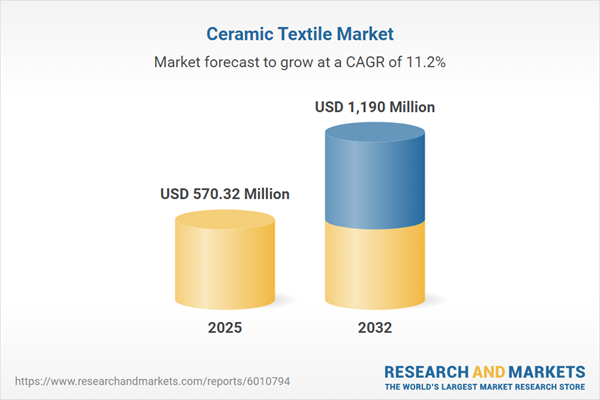Speak directly to the analyst to clarify any post sales queries you may have.
Ceramic textiles are rapidly transforming risk management and compliance strategies for enterprises in regulated, high-stakes industries. Increasing demand for operational safety and resilient infrastructure positions ceramic textiles as a fundamental asset for organizations navigating evolving standards and complex technical requirements.
Market Snapshot: Ceramic Textile Market
The ceramic textile market is experiencing strong momentum fueled by broad integration within automotive, aerospace, construction, oil and gas, and power generation. The segment attained a market value of USD 513.40 million in 2024 and is projected to reach USD 570.32 million in 2025, with long-term forecasts anticipating growth to USD 1.19 billion by 2032. With a compound annual growth rate (CAGR) of 11.16%, the market underscores industry-wide priorities such as lightweight material deployment, enhanced thermal stability, and increased chemical durability. As organizations implement ceramic textiles across critical operations, leaders are recognizing their importance for boosting operational efficiency, regulatory compliance, and robust lifecycle cost controls—reinforcing the material’s growing role in high-performance applications.
Ceramic Textile Market Scope & Segmentation
Detailed segmentation provides a roadmap for organizations aiming to identify high-value applications and drive transformative procurement strategies across global operations. Companies can better align their investments by focusing on the following key areas:
- Product Types: Braided, nonwoven, and woven formats deliver a balance of abrasion resistance and flexibility, supporting effective performance in demanding and unpredictable settings.
- Fiber Types: Options including alumina, carbon, silica, and zirconia fibers enable organizations to address high-temperature environments, ensure mechanical integrity, and withstand chemical exposure.
- Applications: Widely used for ballistic and industrial armor, these textiles facilitate filtration for liquids and gases, provide comprehensive thermal and acoustic insulation, and strengthen structural reinforcements crucial to operational reliability.
- End Users: Organizations in sectors such as automotive, aerospace, construction, oil and gas, and energy expansion leverage ceramic textiles to navigate strict requirements and adapt to diverse operational contexts.
- Regional Coverage: EMEA emphasizes ongoing compliance and safety initiatives; Asia-Pacific focuses on scaling production to drive wider adoption; the Americas work toward technical improvements and established supply chain efficiencies.
- Featured Companies: Key market participants include Morgan Advanced Materials Plc, Mersen S.A., Compagnie de Saint-Gobain S.A., 3M Company, RHI Magnesita GmbH, AGC Inc., Shin-Etsu Chemical Co., Ltd., Johns Manville Corporation, Resco Products, Inc., and Rath AG, all of whom are fostering innovation and new partnerships that redefine market expectations.
Key Takeaways for Senior Decision-Makers
- Strategic partnerships and targeted investments align material risk management with evolving sustainability objectives for improved business resilience.
- Emerging digital weaving methods and advanced surface coatings expand the operational scope of ceramic textiles into previously inaccessible market verticals and use cases.
- Strengthened supply chain transparency, including robust traceability and ethical sourcing, enhances compliance capabilities and supports improved competitive standing.
- Innovative developments in ceramic filtration and insulation are driving process efficiency and supporting organizations in advancing toward environmental performance goals.
- Collaborative ventures between manufacturing and technology providers yield customized solutions to support agile adaptation as regulatory landscapes and market conditions evolve.
- Suppliers play a growing advisory role, offering independent validation and technical guidance that facilitate measurable improvements and bolster trust with procurement teams.
Analyzing Tariff Impact on Ceramic Textile Supply Chains
Forthcoming tariff adjustments in the United States are compelling organizations to reassess sourcing and procurement frameworks. In response, companies are diversifying supplier networks, negotiating extended contracts, and evaluating opportunities for domestic production to mitigate risks. Enhanced inventory protocols and compliance measures are being adopted to bolster supply chain resilience through shifting international trade environments and procurement uncertainty.
Methodology & Data Sources
This analysis draws upon interviews with industry executives, R&D leaders, and procurement specialists. Findings are supported by systematic reviews of technical literature, patent filings, regulatory updates, and sector-specific market research studies to ensure actionable insights.
Why This Report Matters
- Enables senior leaders to make data-driven, compliance-focused decisions about ceramic textiles across challenging and regulated enterprise contexts.
- Equips engineering and procurement teams with targeted guidance to address changing technical standards and ensure operational continuity amid evolving benchmarks.
- Facilitates greater oversight of supply chains and risk mitigation, preparing organizations for proactive response to regulatory and operational shifts.
Conclusion
Ceramic textiles empower organizations to anticipate market shifts, strengthen operational processes, and enhance adaptability within stringent regulatory environments.
Additional Product Information:
- Purchase of this report includes 1 year online access with quarterly updates.
- This report can be updated on request. Please contact our Customer Experience team using the Ask a Question widget on our website.
Table of Contents
3. Executive Summary
4. Market Overview
7. Cumulative Impact of Artificial Intelligence 2025
Companies Mentioned
The companies profiled in this Ceramic Textile market report include:- Morgan Advanced Materials Plc
- Mersen S.A.
- Compagnie de Saint-Gobain S.A.
- 3M Company
- RHI Magnesita GmbH
- AGC Inc.
- Shin-Etsu Chemical Co., Ltd.
- Johns Manville Corporation
- Resco Products, Inc.
- Rath AG
Table Information
| Report Attribute | Details |
|---|---|
| No. of Pages | 193 |
| Published | October 2025 |
| Forecast Period | 2025 - 2032 |
| Estimated Market Value ( USD | $ 570.32 Million |
| Forecasted Market Value ( USD | $ 1190 Million |
| Compound Annual Growth Rate | 11.1% |
| Regions Covered | Global |
| No. of Companies Mentioned | 11 |









